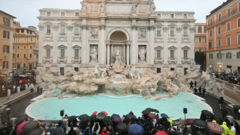Following a three-month restoration, Rome's Trevi Fountain has reopened with a new crowd management system to enhance visitor experience and preserve the site’s integrity, while authorities consider a potential entry fee for maintenance costs.
Rome Implements Crowd Control Measures at Trevi Fountain Post-Restoration

Rome Implements Crowd Control Measures at Trevi Fountain Post-Restoration
New queuing system introduced to manage tourist influx after extensive restoration of the iconic landmark.
The world-renowned Trevi Fountain in Rome has officially reopened to the public after undergoing a significant three-month restoration effort. Originally designed by Italian architect Nicola Salvi in the 18th Century, this iconic baroque structure, located on the façade of the Poli Palace, attracts enormous crowds, with estimates of daily visitors ranging from 10,000 to 12,000.
To tackle the overwhelming number of tourists frequenting the area, Rome's officials have introduced a new queuing system aimed at preventing large gatherings around this historic fountain. Mayor Roberto Gualtieri expressed the intention behind this initiative, stating that the measures will “allow everyone to better enjoy the fountain, without crowds or confusion.”
On the day of the reopening, tourists braved light rain to gather around the fountain, with many indulging in the traditional practice of tossing coins into the water, a custom popularized by Frank Sinatra’s film “Three Coins in the Fountain.” This ritual not only serves as a wish-making tradition but also generates substantial charitable contributions, with around €10,000 collected weekly to support meals for the city's needy.
The restoration project, which involved extensive cleaning to remove mold and mineral buildup, was crucial to addressing the fountain's deteriorating condition—a situation highlighted in 2012 when parts of its ornate cornice began to fall due to severe weather. The city plans to maintain the fountain's beauty and ensure its viability, particularly with the forthcoming Roman Catholic Church jubilee beginning on Christmas Eve.
As part of these long-term maintenance plans, city officials are also contemplating the introduction of a modest entry fee aimed at preserving the fountain’s grandeur. Meanwhile, tourists can continue to enjoy the enchanting view of the Trevi Fountain, a celebrated endpoint of the ancient Acqua Vergine aqueduct that has centuries of history flowing through it.
To tackle the overwhelming number of tourists frequenting the area, Rome's officials have introduced a new queuing system aimed at preventing large gatherings around this historic fountain. Mayor Roberto Gualtieri expressed the intention behind this initiative, stating that the measures will “allow everyone to better enjoy the fountain, without crowds or confusion.”
On the day of the reopening, tourists braved light rain to gather around the fountain, with many indulging in the traditional practice of tossing coins into the water, a custom popularized by Frank Sinatra’s film “Three Coins in the Fountain.” This ritual not only serves as a wish-making tradition but also generates substantial charitable contributions, with around €10,000 collected weekly to support meals for the city's needy.
The restoration project, which involved extensive cleaning to remove mold and mineral buildup, was crucial to addressing the fountain's deteriorating condition—a situation highlighted in 2012 when parts of its ornate cornice began to fall due to severe weather. The city plans to maintain the fountain's beauty and ensure its viability, particularly with the forthcoming Roman Catholic Church jubilee beginning on Christmas Eve.
As part of these long-term maintenance plans, city officials are also contemplating the introduction of a modest entry fee aimed at preserving the fountain’s grandeur. Meanwhile, tourists can continue to enjoy the enchanting view of the Trevi Fountain, a celebrated endpoint of the ancient Acqua Vergine aqueduct that has centuries of history flowing through it.




















